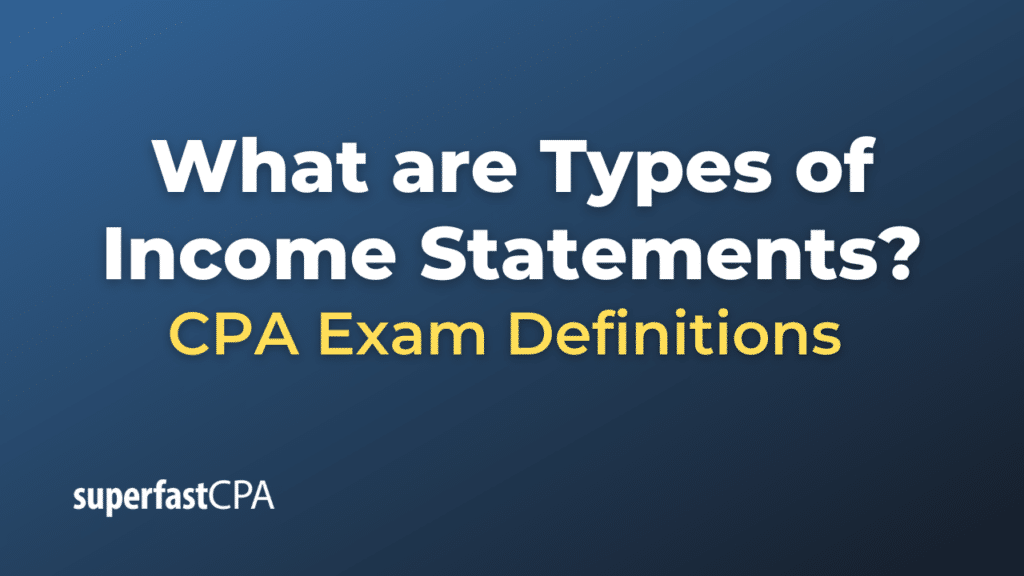Types of Income Statements
The income statement, also known as the profit and loss statement, provides information about a company’s revenue, expenses, and profits over a specific period of time. There are two primary types of income statements:
- Single-Step Income Statement:
Net Income = (Revenues + Gains) – (Expenses + Losses)
- This format is generally used by smaller businesses or entities with relatively simple operations.
- This format is more detailed and separates operating revenues and expenses from non-operating ones. It highlights several important financial metrics, including gross profit and operating income.
- Breakdown:
- Operating Section:
- Sales: Gross sales, returns, and allowances are shown here.
- Cost of Goods Sold (COGS): Displays the direct costs associated with producing goods.
- Gross Profit : Calculated as Sales minus COGS.
- Operating Expenses: These are divided into selling expenses (related to the sale of products or services) and administrative expenses (general operational expenses).
- Operating Income : Calculated as Gross Profit minus Total Operating Expenses.
- Non-operating Section:
- Contains revenues and expenses not related to the primary operations of the business. This includes items like interest income, interest expense, gains or losses from the sale of assets, and other non-recurring items.
- Income Before Tax : Operating income plus/minus non-operating items.
- Income Tax Expense: Taxes on the income.
- Net Income: Income before tax minus income tax expense.
- Operating Section:
Depending on the company and the industry, there might also be variations or additional segments in the income statement, especially if the company has other unique categories of revenues, gains, expenses, or losses.
For clarity, public companies often use the multi-step format as it provides more detailed information to investors and other stakeholders.
Example of Types of Income Statements
Let’s use a fictional company named “NovelBooks Inc.” and create examples of both a single-step and multi-step income statement for the year ended December 31, 2023.
1. Single-Step Income Statement for NovelBooks Inc.
Total Revenues and Gains:
- Book Sales: $500,000
- Royalties Received: $50,000
- Gain from Sale of Old Printing Machine: $10,000
Total: $560,000
Total Expenses and Losses:
- Cost of Goods Sold: $300,000
- Salary Expenses: $100,000
- Rent: $40,000
- Marketing and Advertising: $20,000
- Loss from Lawsuit Settlement: $10,000
Total: $470,000
Net Income: $560,000 (Total Revenues and Gains) – $470,000 (Total Expenses and Losses) = $90,000
2. Multi-Step Income Statement for NovelBooks Inc.
Sales:
- Gross Book Sales: $510,000
- Sales Returns and Allowances: -$10,000
Net Sales: $500,000
Cost of Goods Sold: $300,000
Gross Profit: $500,000 (Net Sales) – $300,000 (COGS) = $200,000
Operating Expenses:
- Salary Expenses: $100,000
- Rent: $40,000
- Marketing and Advertising: $20,000
Total Operating Expenses: $160,000
Operating Income: $200,000 (Gross Profit) – $160,000 (Total Operating Expenses) = $40,000
Other Revenues and (Expenses):
- Royalties Received: $50,000
- Gain from Sale of Old Printing Machine: $10,000
- Loss from Lawsuit Settlement: -$10,000
Total Other Revenues and (Expenses): $50,000
Income Before Tax: $40,000 (Operating Income) + $50,000 (Total Other Revenues and Expenses) = $90,000
Income Tax Expense: (Assuming a 20% tax rate) $18,000
Net Income: $90,000 (Income Before Tax) – $18,000 (Tax) = $72,000
The multi-step format provides a more detailed view of the company’s financial performance, breaking down the results from its core operations separately from other non-operating activities.













